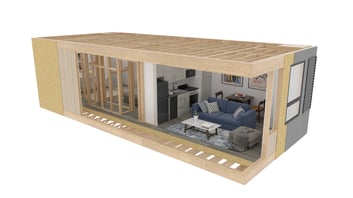Contents

The possibilities of modular construction have evolved far beyond what was ever thought possible. This construction method has become a favorite among developers for large-scale projects like hotels, apartment structures, and other forms of affordable housing, but with this rise in popularity comes a new challenge.
How does financing these projects work?
What is Modular Construction?
Modular construction involves constructing the pieces of the structure off-site in a factory. These pieces, commonly known as modules, are then transported to the site where a team has already.jpg?width=342&height=228&name=VBC_Edgewater_SetWeek1_004%20(1).jpg) prepared the foundation. The units are then craned in and secured, creating a fully operational building in just a matter of months.
prepared the foundation. The units are then craned in and secured, creating a fully operational building in just a matter of months.
You can view this construction method in action here.
The construction process itself is mostly seamless, but since the sequence of events differs from traditional construction, so does the financing process.
Who is Involved in Modular Construction Financing?
There are three key players when it comes to financing large-scale modular construction projects.
Developer
Think of the developer as the ringleader of the project. This is the person who conceptualizes the project from the start and gets everything in motion. They will also own the land on which the project will be built and carry the most responsibility.
As the owner of the project, they will also sponsor the majority of the project and are known as the general partner.
Investors
Investors will be key stakeholders in the project. As they have an equity stake in the deal, they will become limited partners in the project
Lender
In most projects, lenders are one of the most important players in large-scale construction projects as they will fund 50-75% of the project.
We’ll dive into the whole process later.
Modular Construction Company
For large-scale projects, you’ll want to find a company that specializes in building modular structures of this size like Volumetric Building Companies (VBC).
VBC handles all components of the construction process in major cities like New York, Los Angeles, the Bay Area, and Philadelphia.
How Does Modular Construction Financing Work?: Step-by-Step Process
Due to the difference in the sequence of events, the financing process for large-scale modular projects differs from traditional construction which typically bills on completion percentage.
Step #1: Initial Assessment and Project Plan
Developers will begin by conducting an initial assessment of the construction requirements.
This involves creating a comprehensive project plan, including budget estimates, timelines, and design specifications for the modular building.
Step #2: Contacting Lenders and Loan Approval
Once the details of the project have been finalized, the developer will begin reaching out to a variety of banks and other lending entities to pitch the project.
If a lender is interested in financing the project, the bank will issue a term sheet. A term sheet in modular construction financing typically includes essential details and terms related to the financial arrangement. It will outline key aspects such as the loan amount, interest rates, repayment terms, collateral requirements, and any special conditions specific to the modular construction project.
The term sheet acts as a starting point for negotiations and discussions between the parties involved, allowing the developer and the lender to align on the fundamental terms before moving forward.
Once all parties are in agreement, they sign a loan agreement and the next phase begins.
Step #3: Engaging Modular Construction Companies
With financing secured, the developer can begin contacting modular construction companies to talk details. Discussions will usually involve ensuring that the project aligns with the agreed-upon timelines and specifications.
Step #4: Down Payment
Upon finalizing agreements, the developer will be asked to put a 20-30% down payment on the modular project. This down payment will secure their manufacturing spot in the production line and the materials used in the modules.
However, the developer still does not touch the loan at this point. It’s common practice for the developer to spend all their equity first to fund the project. Loans are usually used for the final portion of the project to get it to the finish line.
Step #5: Construction Phase Begins
This is where you’ll see the most difference in the financing process between modular and traditional construction.
Traditional construction follows a linear process in that one step is completed before the other. For example, the foundation needs to be poured before the walls can be built. Thus, billing in a traditional construction project is based on the percentage completed. This makes sense in theory, but this leads to a lot of variability as the definition of what is considered completed varies from contractor to contractor.
With modular construction, different phases can happen simultaneously as the modules are built offsite in a heavily regulated factory. This means two things:
- Billings happen at a much earlier time in the timeline.
- Billing is more exact.
Payments could be made at intervals, such as upon the completion of a set number of modules or as stages of the manufacturing process are finished.
At this point, the developer will likely need to pull from the loan through what is called a construction draw. A construction draw on a loan is an incremental principal advance on a loan amount from a lender on a construction loan. Whenever the developer needs funds, they submit a request package.
Step #6: Request Package and Construction Draws from Lender
The lender will likely require the following things in the request package:
- Draw Request Form: A standardized form provided by the lender that outlines the specifics of the draw being requested, including the amount, purpose, and timing.
- Progress Report: A detailed report indicating the progress made on the project since the last draw. This report may include information on completed work, milestones achieved, and any deviations from the original project plan.
- Budget Breakdown: An updated breakdown of the project budget, showcasing the allocated funds, actual expenditures, and funds remaining for the project. This ensures transparency regarding the use of funds.
- Invoices and Receipts: Copies of invoices, receipts, or other supporting documentation for completed work, materials purchased, or services rendered. These documents validate the expenses associated with the draw request.
The developer will make construction draws as needed until the project is completed.
Financing Advantages of Modular Construction for Large-Scale Projects
More Precision in Billing Timeline
Billing aligns with specific stages of completion, allowing for accurate financial tracking and payments based on achieved milestones. This precise billing system ensures that funds are released as distinct phases of the project are completed, minimizing financial discrepancies and enabling more effective cost management throughout the construction process.
Lower Contingency Budget
As modular construction factories are heavily regulated and processes have been streamlined, modular factories have a much better idea of the materials and labor needed to complete a project than a traditional construction project.
In turn, this reduces the need for a large contingency budget. A contingency budget is a portion of funds set aside for unexpected costs and delays. The lower the contingency budget needed, the more accurate your budgeting and cost control will be.
Shorter Timeline
Time is one of the biggest advantages of modular construction in large-scale construction projects, not just because of convenience, but cost savings as well.
On average, modular construction projects finish 40-50% faster than traditional construction projects.
A shorter construction timeline equates to less interest payments for the developer, fewer fees from the city for construction permits, and less labor costs for project managers, security, etc.
Labor Savings
If you plan on building your project in a high-cost city like New York or Los Angeles, you’ll experience even more savings by choosing modular for your large-scale project rather than traditional construction.
Modular companies, like Volumetric Building Companies (VBC) will build their factories in low-cost areas like Tracy, California where labor costs are lower than where the project site is located.
Get a quote for your large-scale modular project
VBC has been at the forefront of modular construction for over a decade now, having built some of the largest modular structures in major cities like New York, London, Philadelphia, Amsterdam, and more.
Contact our team to talk about your project details for a quote and feasibility study to find out what we can do for your next project.
Thank you to Ryan Briglia, Real Estate Associate of VBC for his contributions to this blog.

